
Anyone living in Zone 10 areas would tell you that they get to enjoy the splendors of gardening all year round because of the mild climate. Thanks to the hot summers, most plants can thrive effortlessly, and perennials are no exceptions!
If you’re looking for something in the edible department, have a look at our article on ‘Growing Perennial Vegetables in Zone 10’.
Below, I’ve compiled a list of various types of Zone 10 flowers for your gardening needs:
Table of contents
- 1. Pale Purple Coneflower (Echinacea Pallida)
- 2. Mexican Flower Vine (Pseudogynoxys Chenopodioides)
- 3. Love-Lies-Bleeding (Amaranthus Caudatus)
- 4. Cosmos
- 5. Bulbine (Bulbine Frutescens)
- 6. Metallic Leaf Begonia (Begonia)
- 7. Hot Water Plant (Achimenes)
- 8. Bigleaf Hydrangea (Hydrangea Macrophylla)
- 9. Common Impatiens (Impatiens Walleriana)
- 10. Wishbone Flower (Torenia Fournieri)
- 11. Fragrant Sand Verbena (Abronia Fragrans)
- 12. Sweet Osmanthus (Osmanthus Fragrans)
- 13. Bugleweed (Ajuga Reptans)
- 14. Amaryllis (Hippeastrum)
- 15. Annual Phlox (Phlox Drummondii)
- 16. Ginger Lily (Hedychium)
- 17. Tiger Flowers (Tigridia)
- 18. Fan Flower (Scaevola Aemula)
- 19. Golden Trumpet (Allamanda Cathartica)
- 20. Peruvian Lily (Alstroemeria)
- 21. Cape Honeysuckle (Tecoma Capensis)
- 22. Million Bells (Calibrachoa x hybrida)
- 23. False Chamomile (Boltonia Asteroides)
- 24. Ice Plant (Delosperma Cooperi)
- 25. Scarlet Sage (Salvia Splendens)
- 26. Paperbush (Edgeworthia Chrysantha)
- 27. Christmas Cactus (Schlumbergera Truncata)
- 28. Poinsettia (Euphorbia Pulcherrima)
- 29. Winter Jasmine (Jasmine Nudiflorum)
- 30. Florist’s Cyclamen (Cyclamen Persicum)
- 31. Desert Rose (Adenium)
- 32. Indian Hawthorn (Rhaphiolepis x delacourii)
- 33. Butter Daisy (Melampodium Divaricatum)
- 34. Moss Rose (Portulaca Grandiflora)
- 35. Petunia (Petunia x hybrida)
- 36. Flowering Maple (Abutilon x hybridum)
- 37. Mexican Heather (Cuphea Hyssopifolia)
- 38. Plumeria Rubra (Frangipani)
- 39. Common Lantana (Lantana Camara)
- 40. Bougainvillea (Bougainvillea Spectabilis)
- Frequently Asked Questions About Zone 10 Flowers:
(As an Amazon Associate, I earn from qualifying purchases.)
Let’s start with flowers that will absolutely love growing in FULL SUN exposure:
1. Pale Purple Coneflower (Echinacea Pallida)

- Is this an annual or perennial flower? Perennial.
- How to take care of this flowering plant?
- Sun: 6+ hours of full sun, but it can tolerate less sun under partial shade.
- Soil: Well-draining, slightly acidic soil with pH 4.5 to 7.5.
- Water: Every 10 to 14 days.
- Fertilizer: Yearly application of compost in early spring.
- Special Care: Divide the plant every 3 to 4 years to prevent overcrowding and manage its growth.
- Any special precautions or notes about growing this plant? None!
2. Mexican Flower Vine (Pseudogynoxys Chenopodioides)

- Is this an annual or perennial flower? Perennial.
- How to take care of this flowering plant?
- Sun: 6+ hours of full sun, but it can tolerate less sun under partial shade.
- Soil: Moist, nutrient-rich, well-draining soil.
- Water: Weekly watering, after the soil’s surface dries out.
- Fertilizer: Yearly application of compost in early spring.
- Special Care: Place a trellis support around the plant to keep the vines off the ground where it will readily take root.
- Any special precautions or notes about growing this plant?
- Keep this plant far away from curious pets and humans as it is toxic upon ingestion and requires careful handling with gloves to prevent skin irritation.
- Mexican Flower Vine grows quickly so it may benefit from severe pruning each year to control its growth.
3. Love-Lies-Bleeding (Amaranthus Caudatus)

- Is this an annual or perennial flower? Annual.
- How to take care of this flowering plant?
- Sun: 6+ hours of full sun, but it tolerates less sun under partial shade.
- Soil: Moist, well-draining soil.
- Water: Weekly watering, after the soil’s surface dries out.
- Fertilizer: Yearly application of compost in early spring.
- Special Care: None!
- Any special precautions or notes about growing this plant? None!
4. Cosmos

- Is this an annual or perennial flower? Annual.
- How to take care of this flowering plant?
- Sun: 6+ hours of full sun.
- Soil: Well-draining soil.
- Water: Every 7 to 10 days, after the soil’s surface dries out.
- Fertilizer: Unnecessary.
- Special Care: Cut down the plant after it has finished flowering in late spring to encourage more blooms to pop up from the fallen seeds.
- Any special precautions or notes about growing this plant? None!
5. Bulbine (Bulbine Frutescens)

- Is this an annual or perennial flower? Perennial.
- How to take care of this flowering plant?
- Sun: 6+ hours of full sun, but it tolerates less sun under partial shade.
- Soil: Well-draining soil.
- Water: Weekly watering, after the soil’s surface dries out.
- Fertilizer: Yearly application of compost in early spring.
- Special Care: Cut the plant back after it has finished flowering in summer to stimulate new blooms in fall.
- Any special precautions or notes about growing this plant? None!
Not all flowers can take the heat, so with a bit of care and attention, here are some that will do best in SHADE:
6. Metallic Leaf Begonia (Begonia)

- Is this an annual or perennial flower? Perennial.
- How to take care of this flowering plant?
- Sun: 2 to 6+ hours of indirect sunlight.
- Soil: Well-draining soil.
- Water: Weekly watering, after the soil’s surface dries out.
- Fertilizer: Slow-release fertilizer applied in early spring.
- Special Care: Prune old and damaged stems to stimulate new growth.
- Any special precautions or notes about growing this plant? Keep curious pets and humans far away from this plant as it is toxic upon ingestion, especially the roots.
7. Hot Water Plant (Achimenes)

- Is this an annual or perennial flower? Perennial.
- How to take care of this flowering plant?
- Sun: 2 to 6+ hours of indirect sunlight.
- Soil: Well-draining soil.
- Water: Weekly watering, after the soil’s surface dries out. But water less frequently once the plant stops blooming by late fall to winter.
- Fertilizer: A diluted liquid fertilizer applied every 1 to 2 weeks in summer and fall.
- Special Care: Collect pine cone-like tubers formed at the plant’s base once it goes dormant for future replanting.
- Any special precautions or notes about growing this plant? None!
8. Bigleaf Hydrangea (Hydrangea Macrophylla)

- Is this an annual or perennial flower? Perennial.
- How to take care of this flowering plant?
- Sun: 2 to 6+ hours of indirect sunlight with some shade.
- Soil: Moist, well-draining soil.
- Water: Every 5 to 10 days, once the soil’s surface dries out.
- Fertilizer: Yearly application of compost in early spring.
- Special Care: Deadhead spent blooms once the plant has finished flowering to keep it neat and encourage new growth.
- Any special precautions or notes about growing this plant? Keep curious pets away from this plant as its parts are toxic upon ingestion.
9. Common Impatiens (Impatiens Walleriana)

- Is this an annual or perennial flower? Perennial.
- How to take care of this flowering plant?
- Sun: 2 to 6+ hours of indirect sunlight.
- Soil: Moist, nutrient-rich, well-draining soil.
- Water: Weekly watering, after the soil’s surface dries out.
- Fertilizer: Yearly application of compost in early spring.
- Special Care: Cut down ⅓ of the plant after it has finished flowering to stimulate new growth.
- Any special precautions or notes about growing this plant? None!
10. Wishbone Flower (Torenia Fournieri)

- Is this an annual or perennial flower? Annual.
- How to take care of this flowering plant?
- Sun: 2 to 6+ hours of indirect sunlight.
- Soil: Well-draining soil.
- Water: Weekly watering, after the soil’s surface dries out.
- Fertilizer: Slow-release, all-purpose fertilizer applied monthly from spring to fall.
- Special Care: Apply mulch around the plant to retain moisture and keep the roots cool.
- Any special precautions or notes about growing this plant? None!
If you’re the type who can’t wait to see your flowers, here are some that’ll bloom in SPRING:
11. Fragrant Sand Verbena (Abronia Fragrans)

- Is this an annual or perennial flower? Perennial.
- How to take care of this flowering plant?
- Sun: 6+ hours of full sun, but it tolerates less sun under partial shade.
- Soil: Well-draining, loamy or sandy soil.
- Water: Every 7 to 10 days, after the soil’s surface dries out.
- Fertilizer: Slow-release, all-purpose fertilizer applied in spring and summer.
- Special Care: Prune the plant back to stimulate new growth and keep its appearance tidy.
- Any special precautions or notes about growing this plant? None!
12. Sweet Osmanthus (Osmanthus Fragrans)

- Is this an annual or perennial flower? Perennial.
- How to take care of this flowering plant?
- Sun: 6+ hours of full sun with some shade to protect it from the afternoon sun.
- Soil: Moist, well-draining soil.
- Water: Weekly watering, after the soil’s surface dries out.
- Fertilizer: Yearly application of compost in early spring.
- Special Care: While pruning is unnecessary, you can use it to shape the plant however you like.
- Any special precautions or notes about growing this plant? None!
13. Bugleweed (Ajuga Reptans)

- Is this an annual or perennial flower? Perennial.
- How to take care of this flowering plant?
- Sun: Any form of light exposure, from 6+ hours of full sun to even 2 to 6+ hours of indirect sunlight and heavy shade!
- Soil: Moist, well-draining soil.
- Water: Weekly watering, after the soil’s surface dries out.
- Fertilizer: Yearly application of compost in early spring.
- Special Care: Divide the plant every 1 to 2 years to prevent overcrowding and improve air circulation.
- Any special precautions or notes about growing this plant? Due to the plant’s rapid growth rate, it may be considered invasive in some regions. Check your local area whether this is the case before planting it to err on the side of caution.
14. Amaryllis (Hippeastrum)

- Is this an annual or perennial flower? Perennial.
- How to take care of this flowering plant?
- Sun: 6+ hours of full sun with some shade to protect it from the afternoon sun.
- Soil: Nutrient-rich, well-draining soil.
- Water: Weekly watering, after the soil’s surface dries out.
- Fertilizer: A diluted liquid fertilizer applied monthly in spring and summer.
- Special Care: Cut the flowers off once the plant is finished blooming, removing damaged and old leaves as well.
- Any special precautions or notes about growing this plant? Keep curious pets away from this plant as it is toxic upon ingestion, especially the roots.
15. Annual Phlox (Phlox Drummondii)
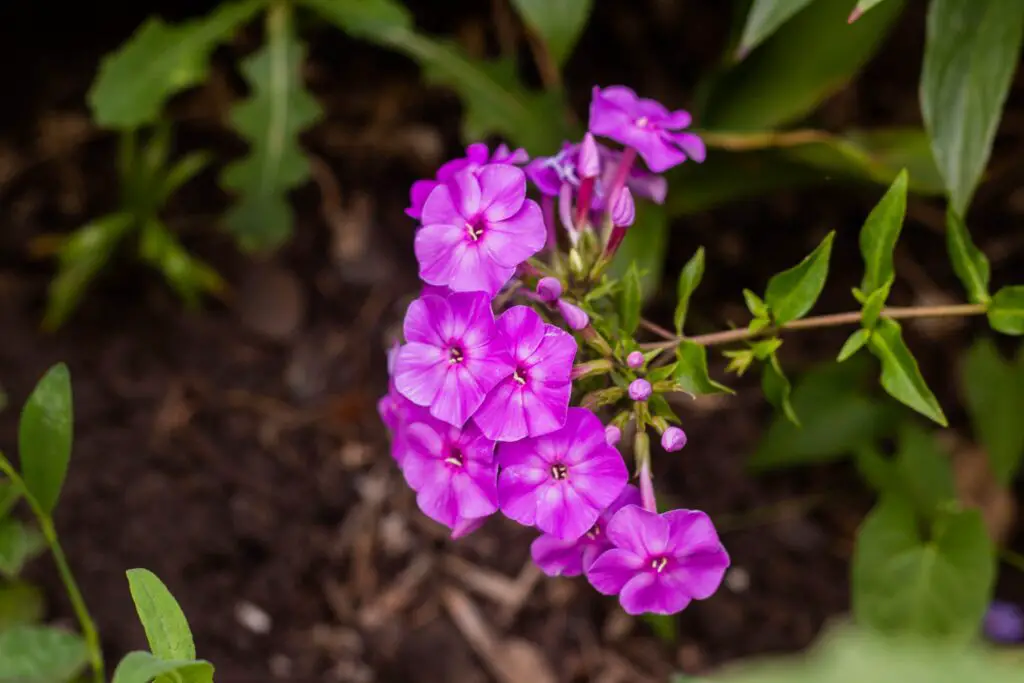
- Is this an annual or perennial flower? Annual.
- How to take care of this flowering plant?
- Sun: 6+ hours of full sun, but it tolerates less sun under partial shade.
- Soil: Well-draining, sandy soil.
- Water: Weekly watering, after the soil’s surface dries out.
- Fertilizer: Yearly application of compost in early spring.
- Special Care: None!
- Any special precautions or notes about growing this plant? Despite being an annual, this plant can easily come back year after year if you leave the flowers to seeds at the end of the season.
In the hottest part of the season, we can’t forget about the flowers that bloom best in SUMMER:
16. Ginger Lily (Hedychium)

- Is this an annual or perennial flower? Perennial.
- How to take care of this flowering plant?
- Sun: 6+ hours of full sun.
- Soil: Moist, nutrient-rich, well-draining soil.
- Water: Every 5 to 7 days, after the soil’s surface dries out.
- Fertilizer: Yearly application of compost in early spring.
- Special Care: None!
- Any special precautions or notes about growing this plant? Despite the name, the roots of a Ginger Lily are inedible.
17. Tiger Flowers (Tigridia)

- Is this an annual or perennial flower? Perennial.
- How to take care of this flowering plant?
- Sun: 6+ hours of full sun.
- Soil: Well-draining, loamy or sandy soil.
- Water: Weekly watering, after the soil’s surface dries out.
- Fertilizer: Yearly application of compost in early spring.
- Special Care: The roots will eventually grow into large clumps, so it’s best to divide them every 2 to 3 years to prevent overcrowding.
- Any special precautions or notes about growing this plant? The roots are edible and are often baked before consumption, as it tastes just like sweet potatoes. However, try not to eat them raw as it is reported to cause a burning sensation in the mouth.
18. Fan Flower (Scaevola Aemula)

- Is this an annual or perennial flower? Perennial.
- How to take care of this flowering plant?
- Sun: 6+ hours of full sun with some shade to protect it from the afternoon sun.
- Soil: Well-draining soil.
- Water: Every 7 to 10 days, after the soil’s surface dries out.
- Fertilizer: A diluted liquid fertilizer applied once in spring and summer.
- Special Care: None!
- Any special precautions or notes about growing this plant? None!
19. Golden Trumpet (Allamanda Cathartica)
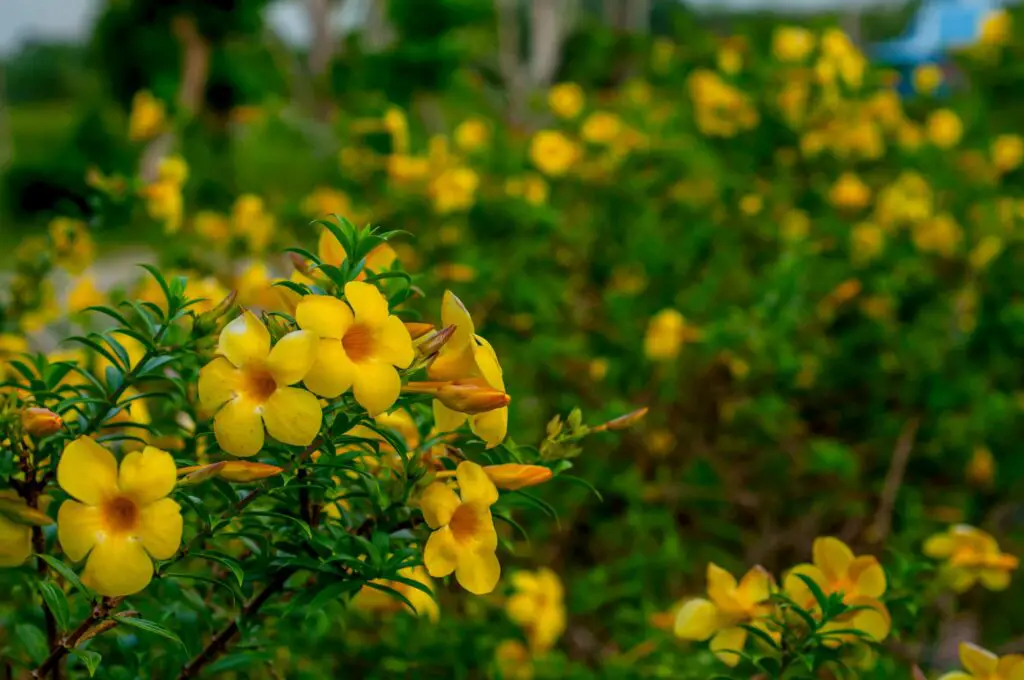
- Is this an annual or perennial flower? Perennial.
- How to take care of this flowering plant?
- Sun: 6+ hours of full sun.
- Soil: Moist, well-draining soil.
- Water: Weekly watering, after the soil’s surface dries out.
- Fertilizer: Yearly application of compost in early spring.
- Special Care: Place a trellis support near the plant and tie them together to manage its growth and prevent choking out other nearby plants.
- Any special precautions or notes about growing this plant? In some tropical areas, this plant is considered invasive due to its climbing trait. Check within your local area whether there are any restrictions about growing this plant before planting.
20. Peruvian Lily (Alstroemeria)

- Is this an annual or perennial flower? Perennial.
- How to take care of this flowering plant?
- Sun: 6+ hours of full sun with some shade to protect it from the afternoon sun.
- Soil: Nutrient-rich, well-draining soil.
- Water: Weekly watering, after the soil’s surface dries out.
- Fertilizer: Yearly application of compost in early spring.
- Special Care: Cut back old and dead leaves at the end of the season to encourage new growth once spring comes. It’s also beneficial to deadhead the flowers after blooming to prevent seeding.
- Any special precautions or notes about growing this plant? Use gloves and protective clothing when handling this plant as it will cause severe skin irritation upon contact.
Even as most plant start to slow down and get rid for the cool season, here are some flowers that are just beginning to bloom in FALL:
21. Cape Honeysuckle (Tecoma Capensis)

- Is this an annual or perennial flower? Perennial.
- How to take care of this flowering plant?
- Sun: 6+ hours of full sun.
- Soil: Moist, well-draining soil.
- Water: Weekly watering, after the soil’s surface dries out.
- Fertilizer: Unnecessary.
- Special Care: Remove old and damaged parts of the plant and prune as necessary to shape it and control its growth from spreading.
- Any special precautions or notes about growing this plant? This plant has been marked as invasive in Australia, so be sure to check if your local area has restrictions about growing this plant.
22. Million Bells (Calibrachoa x hybrida)

- Is this an annual or perennial flower? Perennial.4
- How to take care of this flowering plant?
- Sun: 6+ hours of full sun.
- Soil: Moist, nutrient-rich, well-draining soil.
- Water: Weekly watering, after the soil’s surface dries out.
- Fertilizer: Slow-release, all-purpose fertilizer applied in early spring. Additionally, it benefits from a diluted liquid fertilizer applied monthly from spring to fall.
- Special Care: None!
- Any special precautions or notes about growing this plant? None!
23. False Chamomile (Boltonia Asteroides)

- Is this an annual or perennial flower? Perennial.
- How to take care of this flowering plant?
- Sun: 6+ hours of full sun.
- Soil: Well-draining soil.
- Water: Weekly watering, after the soil’s surface dries out.
- Fertilizer: Yearly application of compost in early spring.
- Special Care: Stake the flowers as needed as they tend to become floppy throughout the season.
- Any special precautions or notes about growing this plant? None!
24. Ice Plant (Delosperma Cooperi)

- Is this an annual or perennial flower? Perennial.
- How to take care of this flowering plant?
- Sun: 6+ hours of full sun.
- Soil: Well-draining, sandy soil.
- Water: Biweekly watering.
- Fertilizer: Yearly application of compost in early spring.
- Special Care: None!
- Any special precautions or notes about growing this plant? None!
25. Scarlet Sage (Salvia Splendens)

- Is this an annual or perennial flower? Perennial.
- How to take care of this flowering plant?
- Sun: 6+ hours of full sun, but it tolerates less sun under partial shade.
- Soil: Well-draining soil.
- Water: Every 7 to 10 days.
- Fertilizer: Yearly application of compost in early spring.
- Special Care: None!
- Any special precautions or notes about growing this plant? None!
But even as the temperatures drops ever so slightly, here are some flowers that continues to bloom in WINTER:
26. Paperbush (Edgeworthia Chrysantha)
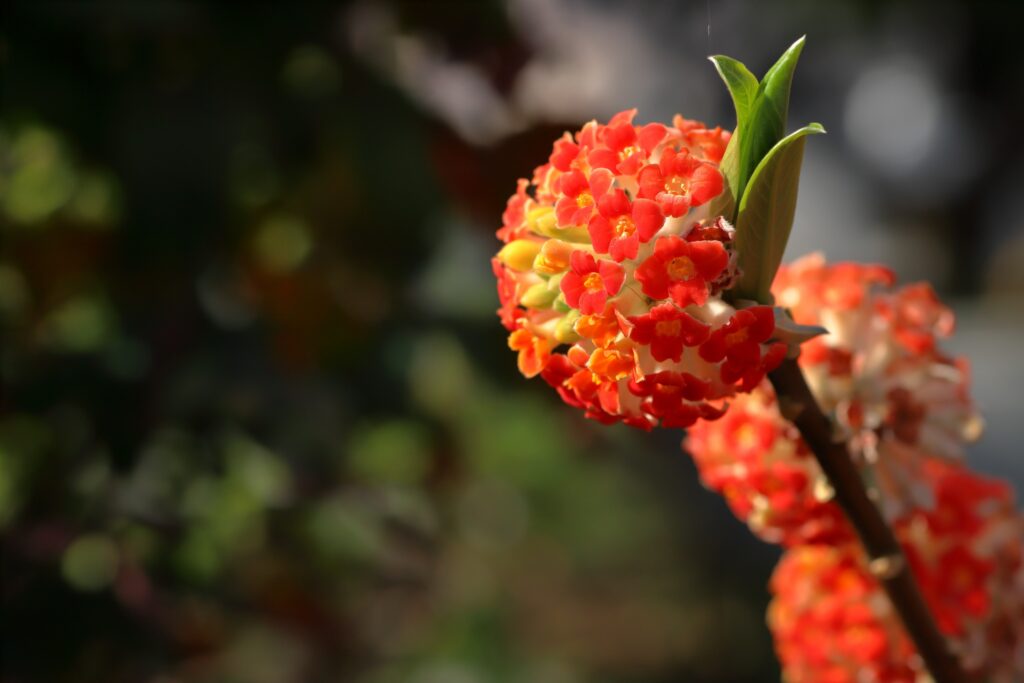
- Is this an annual or perennial flower? Perennial.
- How to take care of this flowering plant?
- Sun: 2 to 6+ hours of indirect sunlight.
- Soil: Nutrient-rich, well-draining soil.
- Water: Weekly watering, after the soil’s surface dries out.
- Fertilizer: Yearly application of compost in early spring.
- Special Care: Prune the plant yearly to get rid of old, dead, and damaged parts.
- Any special precautions or notes about growing this plant? None!
27. Christmas Cactus (Schlumbergera Truncata)

- Is this an annual or perennial flower? Perennial.
- How to take care of this flowering plant?
- Sun: 2 to 6+ hours of indirect sunlight.
- Soil: Well-draining soil.
- Water: Weekly watering, after half the soil dries out.
- Fertilizer: A diluted liquid fertilizer applied monthly in spring and summer.
- Special Care: None!
- Any special precautions or notes about growing this plant? None!
28. Poinsettia (Euphorbia Pulcherrima)

- Is this an annual or perennial flower? Perennial.
- How to take care of this flowering plant?
- Sun: 2 to 6+ hours of indirect sunlight.
- Soil: Well-draining soil.
- Water: Weekly watering, after the soil’s surface dries out.
- Fertilizer: A diluted liquid fertilizer applied in spring before new growth.
- Special Care: Prune the plant back in summer to stimulate new growth and vigor.
- Any special precautions or notes about growing this plant? Be careful when handling this plant as every part can cause skin irritation. The milky sap is also toxic upon ingestion, and may cause allergic reactions for those sensitive to latex.
29. Winter Jasmine (Jasmine Nudiflorum)

- Is this an annual or perennial flower? Perennial.
- How to take care of this flowering plant?
- Sun: 6+ hours of full sun, but it tolerates less sun under partial shade.
- Soil: Moist, well-draining soil.
- Water: Weekly watering, after the soil’s surface dries out.
- Fertilizer: Unnecessary.
- Special Care: Cut the plant back after it’s finished blooming to control its growth.
- Any special precautions or notes about growing this plant? None!
30. Florist’s Cyclamen (Cyclamen Persicum)

- Is this an annual or perennial flower? Perennial.
- How to take care of this flowering plant?
- Sun: 2 to 6+ hours of indirect sunlight.
- Soil: Nutrient-rich, well-draining soil.
- Water: Weekly watering, after the soil’s surface dries out. Stop watering completely once the plant goes dormant in summer.
- Fertilizer: A diluted, liquid fertilizer high in Nitrogen applied in spring.
- Special Care: Deadhead spent flowers to stimulate new blooms to grow.
- Any special precautions or notes about growing this plant? Keep curious pets and humans away from this plant as every part is toxic upon ingestion.
If you’re slightly worried about your flowers lasting through the hot months, here are some DROUGHT-TOLERANT plants that’ll keep blooming:
31. Desert Rose (Adenium)

- Is this an annual or perennial flower? Perennial.
- How to take care of this flowering plant?
- Sun: 6+ hours of full sun.
- Soil: Well-draining, sandy or gravelly soil.
- Water: Every 7 to 14 days, after the soil has completely dried out. In fall and winter, water only once a month.
- Fertilizer: A diluted liquid fertilizer applied in spring and summer.
- Special Care: None!
- Any special precautions or notes about growing this plant? Use gloves and protective clothing when handling this plant as it can cause skin irritation upon contact. It also contains milky sap that is toxic upon ingestion.
32. Indian Hawthorn (Rhaphiolepis x delacourii)

- Is this an annual or perennial flower? Perennial.
- How to take care of this flowering plant?
- Sun: 6+ hours of full sun.
- Soil: Well-draining soil.
- Water: Every 7 to 10 days.
- Fertilizer: Yearly application of compost in early spring.
- Special Care: None!
- Any special precautions or notes about growing this plant? Deers love munching on this plant so ensure to place a fence around your garden.
33. Butter Daisy (Melampodium Divaricatum)

- Is this an annual or perennial flower? Annual
- How to take care of this flowering plant?
- Sun: 6+ hours of full sun.
- Soil: Well-draining soil.
- Water: Every 7 to 10 days.
- Fertilizer: Yearly application of compost in early spring.
- Special Care: Grow this plant in an open space where it’ll get good air circulation and prevent powdery mildew.
- Any special precautions or notes about growing this plant? None!
34. Moss Rose (Portulaca Grandiflora)

- Is this an annual or perennial flower? Annual.
- How to take care of this flowering plant?
- Sun: 6+ hours of full sun.
- Soil: Well-draining, sandy or gravelly soil.
- Water: Every 7 to 14 days.
- Fertilizer: Slow-release, all-purpose fertilizer applied in early spring.
- Special Care: Prune the plant yearly in early spring to prevent overcrowding and improve air circulation.
- Any special precautions or notes about growing this plant? None!
35. Petunia (Petunia x hybrida)

- Is this an annual or perennial flower? Annual.
- How to take care of this flowering plant?
- Sun: 6+ hours of full sun with some shade to protect it from the afternoon sun.
- Soil: Well-draining soil.
- Water: Every 7 to 10 days.
- Fertilizer: Yearly application of compost in early spring. Additionally, feed them a diluted liquid fertilizer biweekly in fall.
- Special Care: Remove spent flowers to encourage new blooms.
- Any special precautions or notes about growing this plant? None!
Last but not least, here are some FLOWERING SHRUBS to decorate your landscape with:
36. Flowering Maple (Abutilon x hybridum)

- Is this an annual or perennial flower? Annual
- How to take care of this flowering plant?
- Sun: 6+ hours of full sun with some shade to protect it from the afternoon sun.
- Soil: Moist, nutrient-rich, well-draining soil.
- Water: Once every 5 to 10 days, after the soil’s surface dries out.
- Fertilizer: Yearly application of compost in early spring.
- Special Care: Cut the branches back to manage its size and promote a more bushier growth.
- Any special precautions or notes about growing this plant? Use gloves when handling this plant as the leaves can irritate the skin upon contact.
37. Mexican Heather (Cuphea Hyssopifolia)
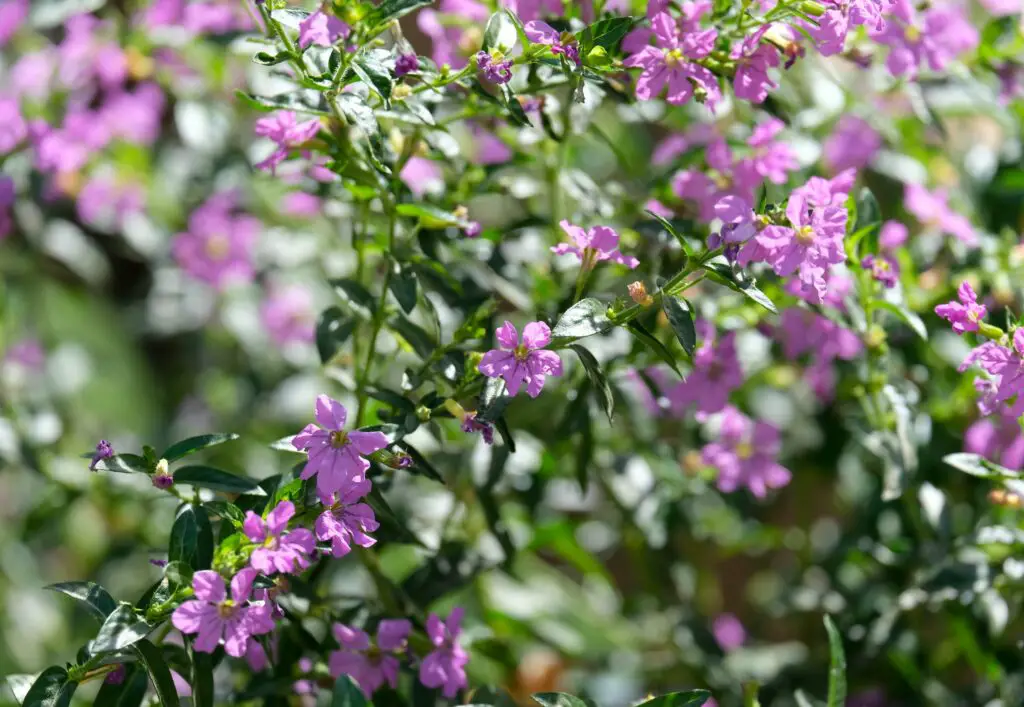
- Is this an annual or perennial flower? Perennial.
- How to take care of this flowering plant?
- Sun: 6+ hours of full sun, but it tolerates less sun under partial shade.
- Soil: Moist, well-draining soil.
- Water: Weekly watering, after the soil’s surface dries out.
- Fertilizer: Yearly application of compost in early spring.
- Special Care: None!
- Any special precautions or notes about growing this plant? None!
38. Plumeria Rubra (Frangipani)

- Is this an annual or perennial flower? Perennial.
- How to take care of this flowering plant?
- Sun: 6+ hours of full sun.
- Soil: Well-draining soil.
- Water: Every 5 to 14 days, after the soil has dried out entirely.
- Fertilizer: Monthly feeding in summer with a fertilizer high in Phosphorus.
- Special Care: Prune the branches back every year to control its growth, keeping it at a manageable size.
- Any special precautions or notes about growing this plant? Be careful not to get the milky sap of a Plumeria Rubra onto your skin or eyes as it can cause irritation. Use gloves and protective goggles when pruning the plant.
39. Common Lantana (Lantana Camara)
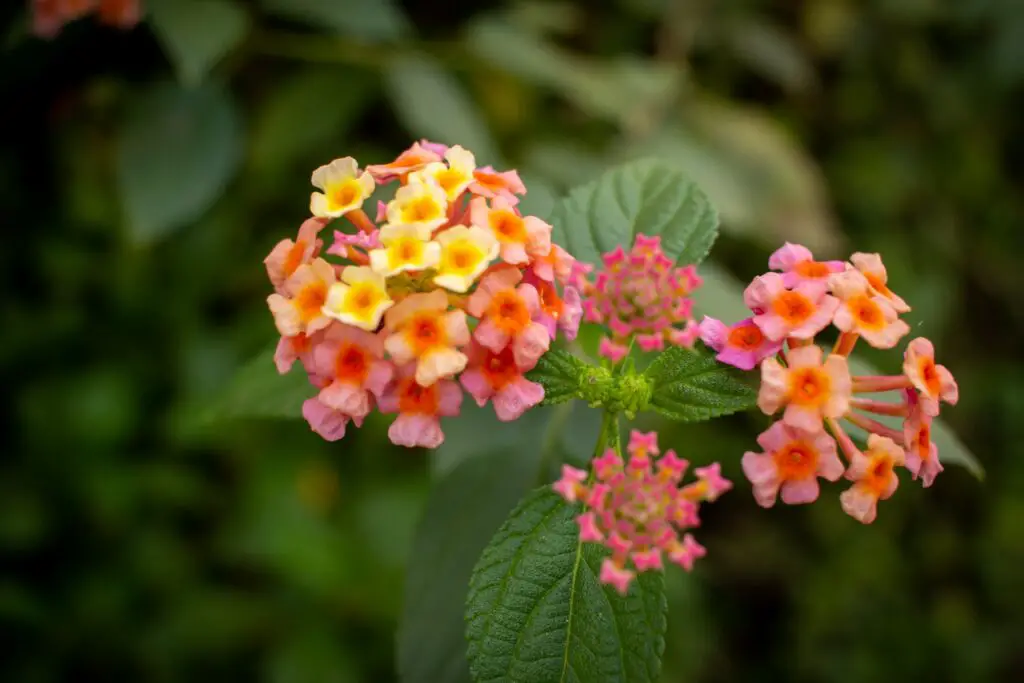
- Is this an annual or perennial flower? Perennial.
- How to take care of this flowering plant?
- Sun: 6+ hours of full sun.
- Soil: Moist, well-draining soil.
- Water: Weekly watering, after the soil’s surface dries out.
- Fertilizer: Yearly application of compost in early spring.
- Special Care: Prune the plant regularly after it has finished flowering to prevent the berries from developing. This prevents it from aggressively spreading and instead, stimulates new branches and flowers instead.
- Any special precautions or notes about growing this plant?
- Keep curious pets and humans away from this plant as it is toxic upon ingestion and will cause mild skin irritation upon contact.
- Check whether the plant is considered invasive in your local area. It has become invasive in Hawaii, so there may be some restrictions in growing this plant.
40. Bougainvillea (Bougainvillea Spectabilis)
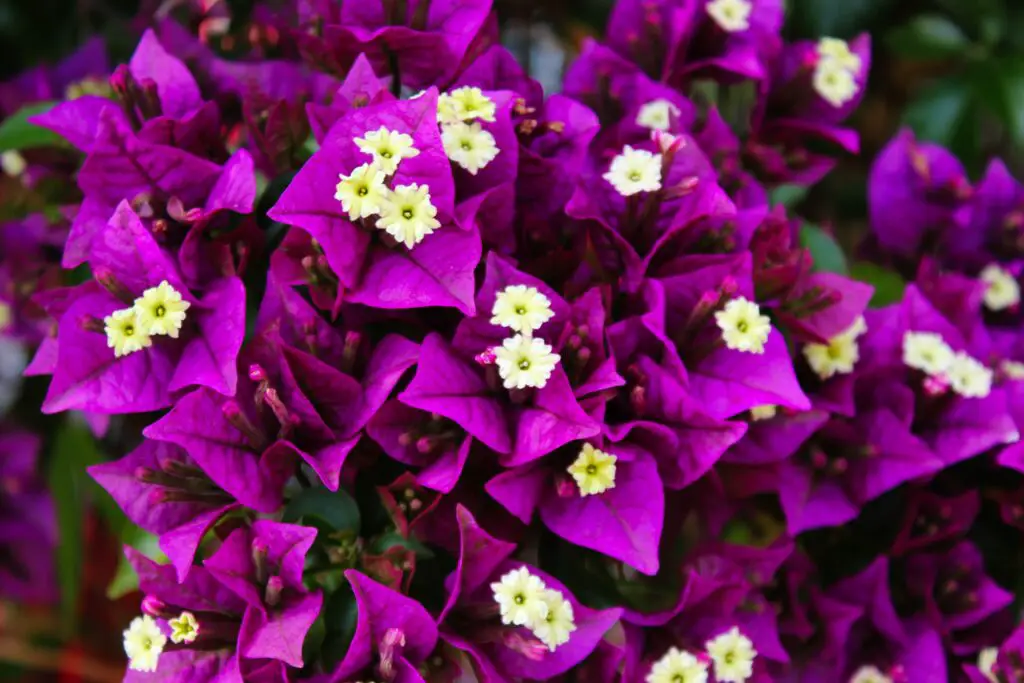
- Is this an annual or perennial flower? Perennial
- How to take care of this flowering plant?
- Sun: 6+ hours of full sun.
- Soil: Nutrient-rich, well-draining soil
- Water: Weekly watering, after half the soil has dried out.
- Fertilizer: Yearly application of compost in early spring.
- Special Care: Prune the plant back as needed after flowering to manage its growth.
- Any special precautions or notes about growing this plant? Bougainvillea branches have multiple curved thorns on them and are best tied to trellis support to prevent further spreading. It may also be helpful to plant it away from highly frequented areas.
Frequently Asked Questions About Zone 10 Flowers:

Daylily ‘Stella de Oro’ can thrive in Zone 10 areas, but not most Daylily varieties. The plant will do best growing in loamy soil and full sun with some shade to protect it from the afternoon sun. Frequent watering is also encouraged to keep the plant cool and well-hydrated in the warm climate.
Certain Hydrangea varieties like Macrophylla can grow easily in Zone 10 as they are of the heat-tolerant variety. However, despite that, they require some shade and prefer indirect sunlight to grow. They’ll also do best in less windy areas so the plant and the soil around it won’t dry out quickly.
Peonies cannot grow in Zone 10 because it requires cool temperatures to thrive in and stimulate blooming. However, there are some cases where people have successfully grown these flowers in warmer climates but it’s extremely difficult. If you’d like to know more about growing this plant, our how-to-guide on ‘Growing Peonies in Northern California’ might interest you.
Only Annual Phlox (Phlox Drummondii) can grow in Zone 10 areas as it is a native plant commonly found in the Southeastern US. The plant requires 6 hours or more of full sun exposure with some shade and well-draining soil to grow well. It’s not particularly picky about its watering needs as it is drought tolerant once established.
Morning Glory (Ipomoea) are easy to grow any time in Zone 10 areas. Scrub the seeds with sandpaper and soak overnight before planting in the soil when the ground has warmed up. However, take note that these flowers can aggressively spread due to their rapid growth rate.
References:
- Abronia fragrans (Fragrant Sand Verbena, Fragrant Sand-verbena, Fragrant Verbena, Fragrent White Sand Verbena, Heart’s Delight, Prairie Snowball, Sand Verbena, Snowball Sand Verbena, Snowball Verbena, Sweet Sand-verbena, Wild Lantana) | North Carolina Extension Gardener Plant Toolbox. Plants. Retrieved January 31, 2023, from https://plants.ces.ncsu.edu/plants/abronia-fragrans/
- Abutilon x hybridum (Chinese Bellflower, Chinese Lantern, Flowering Maple, Parlor Maple) | North Carolina Extension Gardener Plant Toolbox. Plants. Retrieved January 30, 2023, from https://plants.ces.ncsu.edu/plants/abutilon-x-hybridum/
- Achimenes (Cupid’s Bow, Hot Water Plant, Magic Flower, Monkey-faced pansy, Mother’s Tears, Nut-Orchid, Orchid Pansy, Star of India, Widow’s Tears) | North Carolina Extension Gardener Plant Toolbox. Plants. Retrieved January 31, 2023, from https://plants.ces.ncsu.edu/plants/achimenes/
- Adenium (Bushman’s Poison, Desert Rose, Dwarf Bottle Tree, Elephant’s Foot, Impala Lily, Mock Azalea, Sabi Star) | North Carolina Extension Gardener Plant Toolbox. Plants. Retrieved January 31, 2023, from https://plants.ces.ncsu.edu/plants/adenium/
- Ajuga reptans (Ajuga, Blue Bugle, Bugleherb, Bugleweed, Bugle Weed, Carpet Bugle) | North Carolina Extension Gardener Plant Toolbox. Plants. Retrieved January 31, 2023, from https://plants.ces.ncsu.edu/plants/ajuga-reptans/
- Allamanda cathartica (Allamanda, Golden-Trumpet, Golden Trumpet Vine, Yellow Allamanda) | North Carolina Extension Gardener Plant Toolbox. Plants. Retrieved January 31, 2023, from https://plants.ces.ncsu.edu/plants/allamanda-cathartica/
- Alstroemeria (Lily-of-the-Incas, Parrot Lily, Peruvian Lily, Princess Lily) | North Carolina Extension Gardener Plant Toolbox. Plants. Retrieved January 31, 2023, from https://plants.ces.ncsu.edu/plants/alstroemeria/
- Amaranthus caudatus – Plant Finder. Missouribotanicalgarden. Retrieved January 30, 2023, from https://www.missouribotanicalgarden.org/PlantFinder/PlantFinderDetails.aspx?kempercode=a558
- Begonia (Angel wing begonia, Begonia, Belgian Begonias, Climbing, Dragon Wings Begonia, Rex Begonia, Rex Begonias, Tuberous Begonias) | North Carolina Extension Gardener Plant Toolbox. Plants. Retrieved January 31, 2023, from https://plants.ces.ncsu.edu/plants/begonia/
- Boltonia asteroides (Boltonia, Eastern Doll’s Daisy, False Aster, False Chamomile, White Doll’s Daisy) | North Carolina Extension Gardener Plant Toolbox. Plants. Retrieved January 31, 2023, from https://plants.ces.ncsu.edu/plants/boltonia-asteroides/
- Bougainvillea spectabilis (Bougainvillea, Great Bougainvillea, Paper Flower) | North Carolina Extension Gardener Plant Toolbox. Plants. Retrieved January 30, 2023, from https://plants.ces.ncsu.edu/plants/bougainvillea-spectabilis/
- Bulbine frutescens – Plant Finder. Missouribotanicalgarden. Retrieved January 31, 2023, from https://www.missouribotanicalgarden.org/PlantFinder/PlantFinderDetails.aspx?taxonid=282074&isprofile=0&ispr
- Calibrachoa x hybrida (Calibrachoa, Million Bells, Mini Petunia, Trailing Petunia) | North Carolina Extension Gardener Plant Toolbox. Plants. Retrieved January 31, 2023, from https://plants.ces.ncsu.edu/plants/calibrachoa-x-hybrida/
- Cosmos (Cosmos) | North Carolina Extension Gardener Plant Toolbox. Plants. Retrieved January 30, 2023, from https://plants.ces.ncsu.edu/plants/cosmos/
- Cuphea hyssopifolia (Elfin Herb, False Heather, Hawaiian Heather, Mexican Heather) | North Carolina Extension Gardener Plant Toolbox. Plants. Retrieved January 30, 2023, from https://plants.ces.ncsu.edu/plants/cuphea-hyssopifolia/
- Cyclamen persicum (Florist’s Cyclamen, Persian Cyclamen) | North Carolina Extension Gardener Plant Toolbox. Plants. Retrieved January 31, 2023, from https://plants.ces.ncsu.edu/plants/cyclamen-persicum/
- Delosperma cooperi (Cooper’s Hardy Ice Plant, Hardy Ice Plant) | North Carolina Extension Gardener Plant Toolbox. Plants. Retrieved January 31, 2023, from https://plants.ces.ncsu.edu/plants/delosperma-cooperi/
- Echinacea pallida (Pale Purple Coneflower) | North Carolina Extension Gardener Plant Toolbox. Plants. Retrieved January 30, 2023, from https://plants.ces.ncsu.edu/plants/echinacea-pallida/
- Edgeworthia chrysantha (Oriental Paper Bush, Paperbush, Paperbush Plant) | North Carolina Extension Gardener Plant Toolbox. Plants. Retrieved January 31, 2023, from https://plants.ces.ncsu.edu/plants/edgeworthia-chrysantha/
- Euphorbia pulcherrima (Bird-of-Paradise Flower, Christmas Flower, Flame-Leaf Flower, Lobster Flower, Poinsettia) | North Carolina Extension Gardener Plant Toolbox. Plants. Retrieved January 31, 2023, from https://plants.ces.ncsu.edu/plants/euphorbia-pulcherrima/
- Hedychium (Garland Flower, Ginger Lily, Hardy ginger, Kahili Ginger) | North Carolina Extension Gardener Plant Toolbox. Plants. Retrieved January 31, 2023, from https://plants.ces.ncsu.edu/plants/hedychium/
- Hippeastrum (Amaryllis, Barbados Lily, Christmas Rose, Dutch Amaryllis, Fire Lily, Lily of the Palace, Ridderstjerne, South African Amaryllis) | North Carolina Extension Gardener Plant Toolbox. Plants. Retrieved January 31, 2023, from https://plants.ces.ncsu.edu/plants/hippeastrum/
- Hydrangea macrophylla (Bigleaf Hydrangea, French Hydrangea, Hortensia, Lacecap Hydrangea, Mophead Hydrangea, Snowball Plant) | North Carolina Extension Gardener Plant Toolbox. Plants. Retrieved January 31, 2023, from https://plants.ces.ncsu.edu/plants/hydrangea-macrophylla/
- Impatiens walleriana (Bizzy Lizzy, Busy Lizzy, Common Impatiens, Garden Impatiens, Impatiens, Patience Plant, Patient Lucy, Sultana, Sultan’s Flower) | North Carolina Extension Gardener Plant Toolbox. Plants. Retrieved January 31, 2023, from https://plants.ces.ncsu.edu/plants/impatiens-walleriana/
- Jasminum nudiflorum (Winter-flowered Jasmine, Winter Jasmine) | North Carolina Extension Gardener Plant Toolbox. Plants. Retrieved January 31, 2023, from https://plants.ces.ncsu.edu/plants/jasminum-nudiflorum/
- Lantana camara (Common Lantana, Lantana, Red Sage, Shrub Verbena, Yellow Sage) | North Carolina Extension Gardener Plant Toolbox. Plants. Retrieved January 30, 2023, from https://plants.ces.ncsu.edu/plants/lantana-camara/
- Melampodium divaricatum (Butter Daisy, Melampodium) | North Carolina Extension Gardener Plant Toolbox. Plants. Retrieved January 31, 2023, from https://plants.ces.ncsu.edu/plants/melampodium-divaricatum/
- Osmanthus fragrans (Fragrant Tea Olive, Sweet Osmanthus, Tea Olive) | North Carolina Extension Gardener Plant Toolbox. Plants. Retrieved January 31, 2023, from https://plants.ces.ncsu.edu/plants/osmanthus-fragrans/
- Petunia x hybrida (Garden Petunia, Petunia) | North Carolina Extension Gardener Plant Toolbox. Plants. Retrieved January 31, 2023, from https://plants.ces.ncsu.edu/plants/petunia-x-hybrida/
- Phlox drummondii (Annual Phlox, Drummond Phlox, Phlox (annual), Pride of Texas, Texas Belle, Texas Pride) | North Carolina Extension Gardener Plant Toolbox. Plants. Retrieved January 31, 2023, from https://plants.ces.ncsu.edu/plants/phlox-drummondii/
- Plumeria – Wisconsin Horticulture. Hort. Retrieved January 31, 2023, from https://hort.extension.wisc.edu/articles/plumeria/
- Portulaca grandiflora (Moss Rose, Portulaca, Purslane, Rose Moss, Sun Plant) | North Carolina Extension Gardener Plant Toolbox. Plants. Retrieved January 31, 2023, from https://plants.ces.ncsu.edu/plants/portulaca-grandiflora/
- Pseudogynoxys chenopodioides – Plant Finder. Missouribotanicalgarden. Retrieved January 30, 2023, from https://www.missouribotanicalgarden.org/PlantFinder/PlantFinderDetails.aspx?taxonid=277491
- Rhaphiolepis x delacourii (Indian Hawthorn, Rhaphiolepis) | North Carolina Extension Gardener Plant Toolbox. Plants. Retrieved January 31, 2023, from https://plants.ces.ncsu.edu/plants/rhaphiolepis-x-delacourii/
- Salvia splendens (Salvia, Scarlet Sage) | North Carolina Extension Gardener Plant Toolbox. Plants. Retrieved January 31, 2023, from https://plants.ces.ncsu.edu/plants/salvia-splendens/
- Scaevola aemula (Fairy Fan Flower,, Fan Flower) | North Carolina Extension Gardener Plant Toolbox. Plants. Retrieved January 31, 2023, from https://plants.ces.ncsu.edu/plants/scaevola-aemula/
- Schlumbergera truncata (Christmas Cactus, Crab Cactus, False Christmas Cactus, Thanksgiving Cactus) | North Carolina Extension Gardener Plant Toolbox. Plants. Retrieved January 31, 2023, from https://plants.ces.ncsu.edu/plants/schlumbergera-truncata/
- Tecoma capensis (Cape Honeysuckle) | North Carolina Extension Gardener Plant Toolbox. Plants. Retrieved January 31, 2023, from https://plants.ces.ncsu.edu/plants/tecoma-capensis/
- Tigridia (Jockey’s Cap Lily, Mexican Shell Flowers, Peacock Flower, Tiger Flowers) | North Carolina Extension Gardener Plant Toolbox. Plants. Retrieved January 31, 2023, from https://plants.ces.ncsu.edu/plants/tigridia/
- Torenia fournieri (Wishbone Flower) | North Carolina Extension Gardener Plant Toolbox. Plants. Retrieved January 31, 2023, from https://plants.ces.ncsu.edu/plants/torenia-fournieri/






